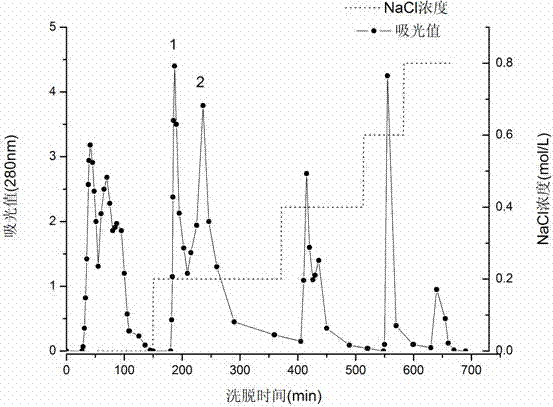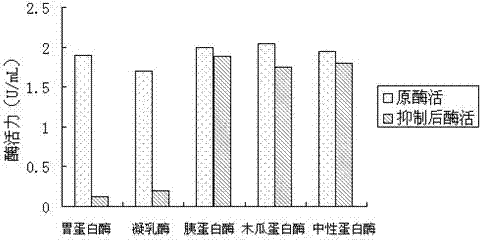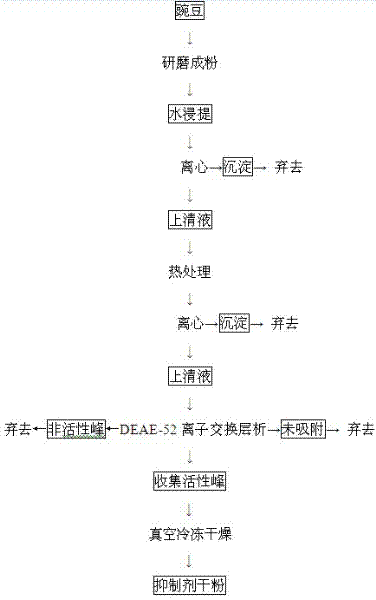Preparation method for pea aspartic acid protease inhibitor
A protease inhibitor, aspartic acid technology, applied in the direction of protease inhibitors, peptide preparation methods, chemical instruments and methods, can solve the problems of protein resource waste, environmental pollution, etc. The effect of pollution
- Summary
- Abstract
- Description
- Claims
- Application Information
AI Technical Summary
Problems solved by technology
Method used
Image
Examples
Embodiment 1
[0029] Wash and bake 50 g of peas immediately, grind them into powder, add 200 mL of ultrapure water at a ratio of 1:4 (w / v), put them in the refrigerator, and extract them at 4°C for 2 h, during which time every half Stir every hour. After leaching, centrifuge the extract at 8000 r / min at 4°C for 30 min to obtain 175 mL of supernatant, put the supernatant in a water bath at 60°C for 20 min, cool to room temperature, and centrifuge at 8000 r / min , centrifuged at 4°C for 30 min to obtain 160 mL of supernatant, the measured concentration ratio of protein to sugar was about 0.98, the pepsin inhibitory unit was about 0.97 IU / mL, and the recovery rate was 87.6%; the supernatant was ionized For exchange chromatography, 20 mL of crude inhibitor was taken each time for DEAE-52 ion exchange chromatography, the size was 30 cm×2.2 cm, and the equilibrium buffer was 10 mmol / L sodium phosphate buffer (pH 6.8). Elution mode: After elution with equilibration buffer for 2 times the column vo...
Embodiment 2
[0031] Wash and bake 50 g of peas immediately, grind them into powder, add 200 mL of ultrapure water at a ratio of 1:4 (w / v), put them in the refrigerator, and extract them at 4°C for 2 h, during which time every half Stir every hour. After leaching, centrifuge the extract at 8000 r / min at 4°C for 30 min to obtain 175 mL of supernatant, put the supernatant in a water bath at 60°C for 20 min, cool to room temperature, and centrifuge at 8000 r / min , centrifuged at 4°C for 30 min to obtain 160 mL of supernatant, the measured concentration ratio of protein to sugar was about 1.05, the pepsin inhibitory unit was about 0.99 IU / mL, and the recovery rate was 88.4%; the supernatant was ionized For exchange chromatography, 20 mL of crude inhibitor was taken each time for DEAE-52 ion exchange chromatography, the size was 30 cm×2.2 cm, and the equilibrium buffer was 10 mmol / L sodium phosphate buffer (pH 6.8). Elution mode: After elution with equilibration buffer for 2 times the column volu...
Embodiment 3
[0033] Wash and bake 50g of peas immediately, grind them into powder, add 200 mL of ultrapure water at a ratio of 1:4 (w / v), put them in the refrigerator, and extract them at 4°C for 2 hours, during which every half hour Stir once. After leaching, centrifuge the extract at 8000 r / min at 4°C for 30 min to obtain 175 mL of supernatant, put the supernatant in a water bath at 60°C for 20 min, cool to room temperature, and centrifuge at 8000 r / min , centrifuged at 4°C for 30 min to obtain 160 mL of supernatant, the measured concentration ratio of protein to sugar was about 1.06, the pepsin inhibitory unit was about 0.98IU / mL, and the recovery rate was 87.4%; the supernatant was ionized For exchange chromatography, 20 mL of crude inhibitor was taken each time for DEAE-52 ion exchange chromatography, the size was 30 cm×2.2 cm, and the equilibrium buffer was 10 mmol / L sodium phosphate buffer (pH 6.8). Elution mode: After elution with equilibration buffer for 2 times the column volume...
PUM
| Property | Measurement | Unit |
|---|---|---|
| recovery rate | aaaaa | aaaaa |
| recovery rate | aaaaa | aaaaa |
| recovery rate | aaaaa | aaaaa |
Abstract
Description
Claims
Application Information
 Login to View More
Login to View More - R&D
- Intellectual Property
- Life Sciences
- Materials
- Tech Scout
- Unparalleled Data Quality
- Higher Quality Content
- 60% Fewer Hallucinations
Browse by: Latest US Patents, China's latest patents, Technical Efficacy Thesaurus, Application Domain, Technology Topic, Popular Technical Reports.
© 2025 PatSnap. All rights reserved.Legal|Privacy policy|Modern Slavery Act Transparency Statement|Sitemap|About US| Contact US: help@patsnap.com



